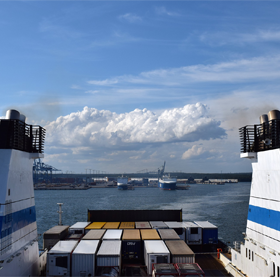Reduced environmental burden from shipping in the Baltic Sea
The Baltic Sea is one of the most heavily trafficked maritime areas in the world, with around 2,000 vessels operating on it at any one time. Shipping has an impact on the marine environment here and is a major contributor to chemical pollution in the form of metals that leach into the sea from primer used on ships. This project will examine and analyse the extent to which this environmental burden affects our inland sea, and will provide a basis for recommendations as to how the release of chemical pollutants from shipping in the Baltic Sea can be reduced.
Antifouling paint is used on ships and boats to reduce biofouling on hulls, which otherwise contributes to increased fuel consumption and increased carbon dioxide emissions. Antifouling paint contains, among other substances, copper and zinc. The leaching rate for copper from paint is thought to be affected by the salinity of water, but how great an impact salinity has is as yet unknown; this knowledge is vital in assessing the burden and impact that shipping has on the Baltic Sea environment.
The aim of this project is to use existing data on ship traffic and new data from antifouling paint to reduce the chemical load compared with current levels. The project will, for example, quantify traffic and contributions to the load using shipping routes, hull area and maintenance, such as hull cleaning, as well as collect new data on the leaching rate of paints and biofouling pressure. This will be done both out in the field and at a laboratory in trials using controlled salinity and biofouling. A newly developed measuring method, based on x-rays, will enable the project team to determine what exactly is in the paint on a hull, what leaching there is and how much copper and zinc a paint needs to contain and release to be effective.
The project will also illustrate potential areas for improvement, such as reduced use of metals in certain areas, and put forward proposals for new strategies to protect against biofouling (e.g. hull cleaning) within certain vessel segments.
Finally, the project will describe how the various parts of the Baltic Sea are affected by chemicals in primer, and will provide a basis for recommendations as to how pollution can be reduced, which may contribute to an improved environmental status for the Baltic Sea.
The project is being led by Lena Granhag, PhD in Marine Ecology, and Erik Ytreberg, PhD in Applied Environmental Science and Ecotoxicology, both based at Chalmers University of Technology (Maritime Environmental Sciences at the Department of Mechanics and Maritime Sciences). The project will run until June 2019.
Continued work
At the beginning of 2019, it was decided that the project would be extended with additional funding from Thurséus forskarhem. The background to the decision is that the project's preliminary results show that the leakage of copper can be decreased by up to 6 times without sacrificing the effectiveness of the color in counteracting hard fouling, which indicates great potential to reduce the load and improve the Baltic Sea's environmental status. The project also aims to investigate, in a similar manner, how soft fouling can be prevented by leakage of zinc pyrithione (ZnPT), but with as low environmental impact as possible.
The result of the project will be communicated to:
- Color manufacturer, to enable the production of more sustainable colors
- Authorities, for relevant policy measures
- The shipping and recreational boat sector regarding which colors are most effective but with low environmental impact

The picture shows a color panel with biofouling. Photo by Erik Ytreberg.

Project status
Project manager

Lena Granhag, PhD in Marine Ecology, and Erik Ytreberg, PhD in Applied Environmental Science and Ecotoxicology, both based at the Department of Mechanics and Maritime Sciences at Chalmers University of Technology.
PROJECT MATERIAL
2019-11-06 Final report
Mot minskad miljöbelastning från båttrafik i Östersjön genom ny kunskap om läckage av gift hos antifoulingfärg (in swedish)
Contact at BalticSea2020







